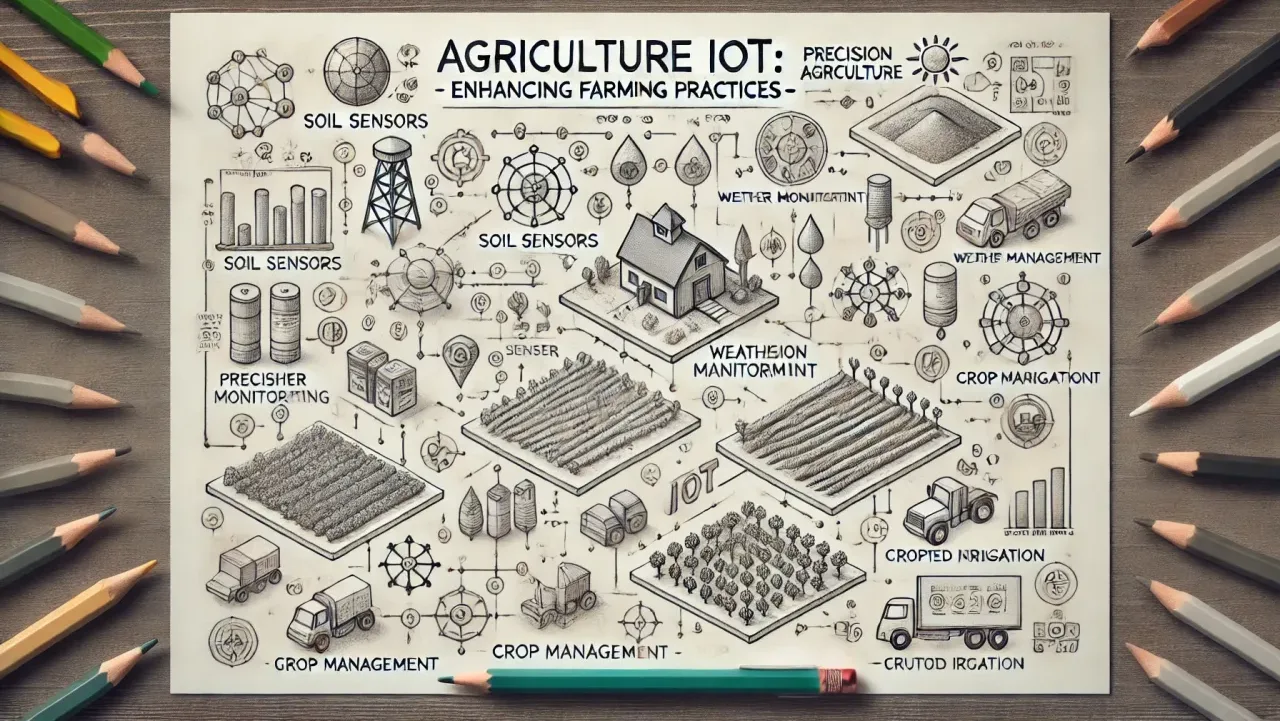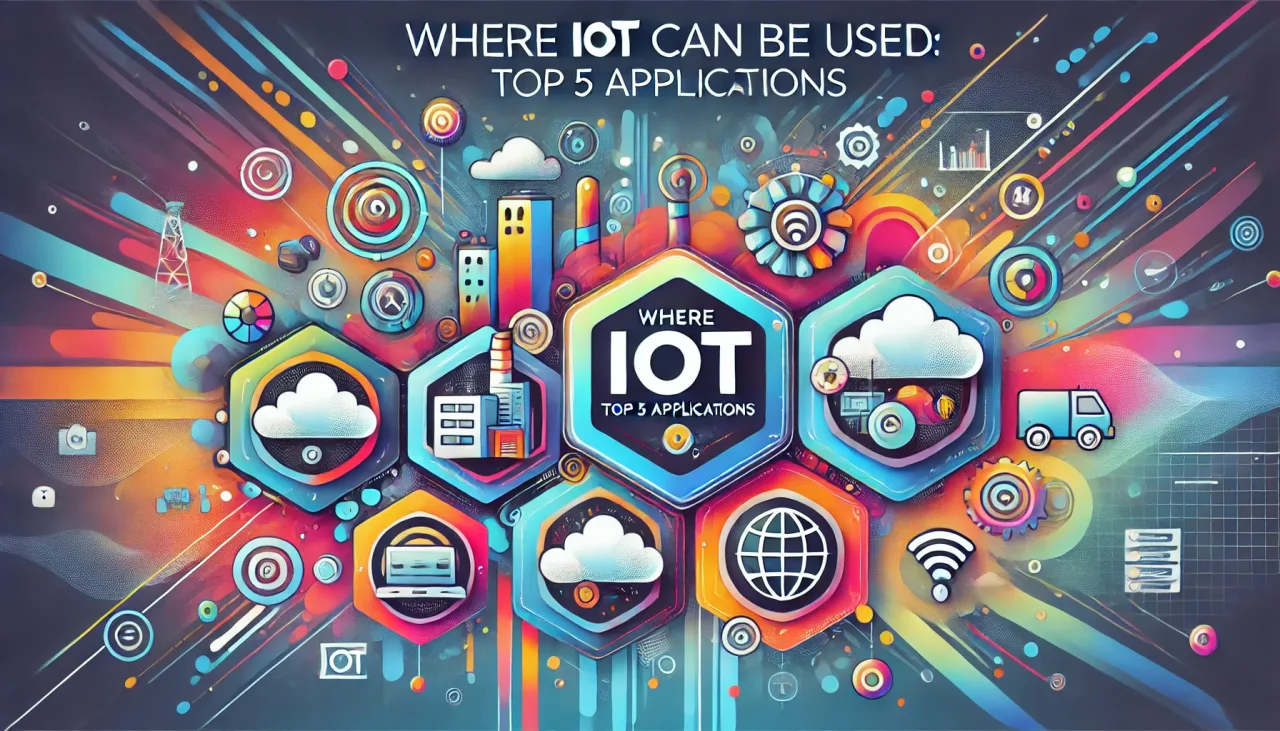In this Article
Introduction
The Internet of Things (IoT) is revolutionizing the way we interact with technology, offering innovative solutions across various industries. From smart homes to industrial automation, IoT applications are transforming traditional systems into intelligent, interconnected networks. Understanding where IoT can be used and its top applications can help businesses and individuals harness its full potential. This comprehensive guide explores the top five applications of IoT and how they are reshaping different sectors. By leveraging IoT, companies can gain a competitive edge, while consumers can enjoy enhanced convenience and efficiency in their daily lives. Moreover, IoT technology fosters new business models and revenue streams, encouraging continuous innovation. As IoT adoption grows, it paves the way for smarter cities, enhanced healthcare, and sustainable practices. The versatility of IoT applications ensures that its impact will be felt across all aspects of modern life, driving forward a more connected and intelligent world.
1. Smart Homes: Enhancing Everyday Living
Home Automation
Smart homes utilize IoT technology to automate and control household functions, improving convenience and energy efficiency. IoT devices such as smart thermostats, lighting systems, and security cameras are interconnected, allowing users to manage them remotely via smartphones or voice commands.
- Energy Efficiency: Smart thermostats and lighting systems can be programmed to adjust settings based on occupancy, reducing energy consumption and costs. These devices learn the habits of the occupants and make adjustments automatically to ensure comfort and efficiency.
- Security: IoT-enabled security cameras and alarm systems provide real-time monitoring and alerts, enhancing home security. These systems can detect unusual activities and notify homeowners immediately, ensuring prompt action.
- Convenience: Voice-controlled assistants and smart appliances simplify daily tasks, offering greater convenience and comfort. From setting reminders to controlling entertainment systems, these devices integrate seamlessly into everyday life.
Home Security
IoT plays a crucial role in enhancing home security through interconnected devices that provide real-time monitoring and alerts.
- Real-Time Monitoring: Security cameras and sensors provide live feeds and alerts, enabling homeowners to monitor their property remotely. This feature is particularly useful for keeping an eye on children, pets, and deliveries.
- Automation: Smart locks and alarm systems can be automated to activate or deactivate based on specific triggers, such as motion detection. This ensures that the home is always secure without requiring manual intervention.
- Integration: Home security systems can be integrated with other smart devices, creating a seamless and comprehensive security solution. For instance, lights can be programmed to turn on when motion is detected, deterring potential intruders.
2. Industrial IoT: Driving Operational Efficiency
Manufacturing

Ai Image by Dall-E
Industrial IoT (IIoT) is revolutionizing manufacturing by enabling real-time monitoring, predictive maintenance, and process optimization.
- Predictive Maintenance: Sensors monitor equipment health, predicting failures before they occur and reducing downtime. This proactive approach to maintenance helps prevent costly breakdowns and extends the lifespan of machinery.
- Process Optimization: Real-time data analysis helps optimize manufacturing processes, improving efficiency and product quality. By monitoring production lines and identifying bottlenecks, manufacturers can streamline operations and reduce waste.
- Asset Tracking: Devices track the location and condition of assets, enhancing inventory management and reducing losses. This ensures that critical components are always available when needed, minimizing production delays.
Supply Chain Management
It enhances supply chain management by providing real-time visibility and data-driven insights.
- Real-Time Tracking: Enabled sensors and GPS devices track the movement of goods, ensuring timely deliveries and reducing losses. This level of visibility helps companies manage logistics more effectively and respond to issues promptly.
- Inventory Management: Automated inventory tracking systems help maintain optimal stock levels, reducing overstock and stockouts. By knowing exactly what is in stock and where it is located, businesses can optimize their inventory and reduce carrying costs.
- Data Insights: Data analytics provide valuable insights into supply chain operations, helping businesses make informed decisions. This data can be used to improve forecasting, plan more efficient routes, and identify areas for cost savings.
3. Healthcare IoT: Improving Patient Care
Remote Patient Monitoring
Healthcare IoT is transforming patient care by enabling remote monitoring and real-time health data analysis.
- Continuous Monitoring: Wearable IoT devices monitor vital signs and transmit data to healthcare providers in real-time. This allows for continuous monitoring of patients’ health, leading to earlier detection of issues and better management of chronic conditions.
- Early Detection: Devices detect abnormalities early, allowing for timely intervention and treatment. For example, a sudden change in heart rate or blood pressure can trigger an alert to the healthcare provider.
- Patient Engagement: Enabled health apps engage patients in managing their health, improving adherence to treatment plans. These apps can remind patients to take their medication, track their activity levels, and provide educational content.
Hospital Management
These technology enhances hospital management by streamlining operations and improving patient outcomes.
- Asset Tracking: Devices track medical equipment and supplies, ensuring their availability and optimal usage. This reduces the time staff spend searching for equipment and ensures that critical items are always on hand.
- Patient Flow Management: Systems monitor patient flow, reducing wait times and improving overall efficiency. By tracking patient movements and identifying bottlenecks, hospitals can optimize their operations and improve patient satisfaction.
- Environmental Monitoring: Sensors monitor environmental conditions, ensuring a safe and comfortable hospital environment. This includes monitoring temperature, humidity, and air quality to maintain optimal conditions for patients and staff.
4. Smart Cities: Transforming Urban Living
Traffic Management
This technology is transforming urban living by optimizing traffic management and improving public safety.
- Smart Traffic Lights: Enabled traffic lights adjust timings based on real-time traffic conditions, reducing congestion. These systems can prioritize emergency vehicles, reduce wait times at intersections, and improve overall traffic flow.
- Public Transportation: Systems provide real-time updates on public transportation, improving efficiency and passenger experience. Passengers can receive notifications about delays, cancellations, and estimated arrival times.
- Parking Management: Sensors detect available parking spaces, guiding drivers to them and reducing traffic congestion. This not only saves time for drivers but also reduces emissions from vehicles searching for parking.
Environmental Monitoring
Now a days smart technology is crucial for monitoring environmental conditions and ensuring sustainable urban development.
- Air Quality Monitoring: Sensors monitor air quality, providing data for pollution control and public health initiatives. This information can be used to implement measures to reduce pollution and protect public health.
- Water Management: Devices monitor water usage and quality, ensuring efficient and sustainable water management. This includes detecting leaks, monitoring water quality, and optimizing irrigation systems.
- Waste Management: Enabled waste bins alert collection services when they are full, optimizing waste collection routes and reducing costs. This helps keep cities clean and reduces the environmental impact of waste management operations.
5. Agriculture IoT: Enhancing Farming Practices
Precision Agriculture

Ai Image by Dall-E
Smart Agriculture is revolutionizing farming practices by enabling precision agriculture and improving crop yields.
- Soil Monitoring: Sensors monitor soil moisture and nutrient levels, optimizing irrigation and fertilization. This ensures that crops receive the right amount of water and nutrients, leading to healthier plants and higher yields.
- Weather Monitoring: Devices provide real-time weather data, helping farmers make informed decisions about planting and harvesting. By knowing the current and forecasted weather conditions, farmers can optimize their operations and reduce risks.
- Pest Control: Technology detects pest infestations early, enabling timely intervention and reducing crop damage. This helps farmers protect their crops and reduce the need for chemical pesticides.
Livestock Management
These technology enhances livestock management by providing real-time monitoring and data-driven insights.
- Health Monitoring: Devices monitor the health and behavior of livestock, detecting illnesses early and reducing mortality rates. This includes tracking vital signs, activity levels, and feeding patterns.
- Location Tracking: GPS-enabled smart devices track the location of livestock, preventing loss and theft. This is particularly useful for managing large herds and ensuring the safety of valuable animals.
- Feed Management: Systems monitor feed consumption, optimizing nutrition and reducing waste. By providing the right amount of feed at the right time, farmers can improve the health and productivity of their livestock.
Conclusion
This technology is revolutionizing various sectors, offering innovative solutions that enhance efficiency, security, and convenience. The top five applications of smart homes, healthcare, agriculture, industrial automation, and smart cities—demonstrate the transformative power of interconnected devices. By understanding these applications, businesses and individuals can make informed decisions to leverage smart technology effectively. Embracing it will not only drive innovation but also support growth and technological advancement across multiple industries.
How We Can Help
At Minnovation, we specialize in providing comprehensive solutions tailored to meet the unique needs of your business. Our expertise in various applications ensures seamless integration, robust security, and enhanced performance. We offer consultation, development, and management services to help you harness the full potential of smart technology. Whether you are looking to implement a new system or optimize your existing infrastructure, our team is here to support you every step of the way. With our cutting-edge solutions, you can stay ahead of the competition and achieve your business goals. Trust Minnovation to deliver innovative smart solutions that drive success and growth in your industry. For more details, visit our site or Contact us.
Reference
Related Blog Posts
How Smart Cities Connect: Getting Started with Edge AI and IoT Technology
How to Get Started with Edge AI and IoT Technologies in Smart Cities: Overcoming Integration Challenges In recent years, the concept of smart cities has evolved from a futuristic Read More
5 Step Strategy: Ensuring Security and Privacy in 15-Minute Smart Cities
Introduction Ensuring security and privacy in 15-minute smart cities is a critical challenge as urban areas become increasingly connected through IoT and edge AI technologies. These cities aim to Read More
What is a smart city and the challenge of legacy systems
How to Get Started with Integrating Legacy Systems in Smart Cities Smart cities are transforming urban landscapes by leveraging technology to improve the quality of life for residents. However, Read More




